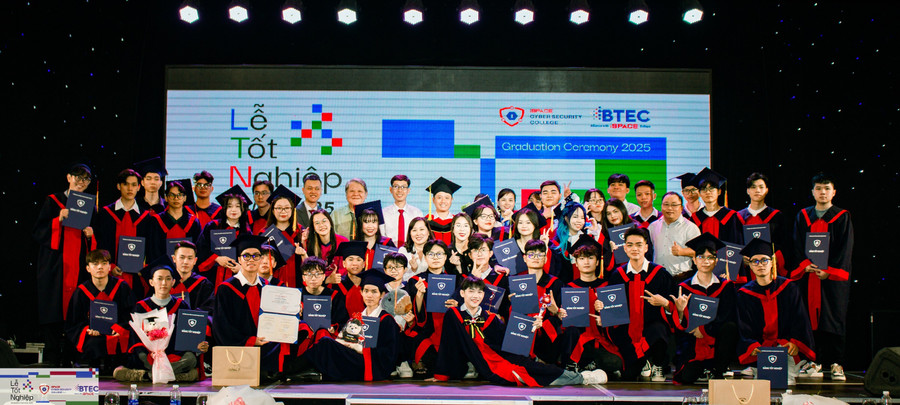Instead of waiting for students to graduate and find jobs, today, businesses themselves are proactively "rolling out the red carpet" and competing fiercely to attract future skilled workers right from when they are still in school.
Choosing to go against the majority
Mr. Nguyen Van Thanh, 30 years old ( Lam Dong ) encountered many doubts from his family and friends when he decided to study Cultural Management at Ho Chi Minh City College of Culture and Arts. "When I chose to study at college, many people did not support me, but after researching, I found out that although the school is a college, it is a key school with good teaching quality," Mr. Thanh confided.
For him, the most important thing is not a university or college degree, but determining what he really wants to choose the right major, study the right profession and develop his career in the best way. That belief and determination have paid off. After graduating, with solid knowledge and skills, Mr. Thanh worked at the Ho Chi Minh City Youth Union, with many contributions to community activities at the agency.
Similarly, Mr. Tran Dang Luu, 35 years old (Vung Tau, Ho Chi Minh City) shared: “I chose to study a trade because the training program is 70% practical, helping students to start working immediately after graduation to earn an income. If they want to continue studying, they can still transfer and develop in the future.”
The path Mr. Luu chose has proven effective. After graduating from intermediate level, he continued to college at College of Technology II and graduated with honors. Practical knowledge and a solid foundation of skills have become a launching pad for him to become not only a skilled worker, but also a talented manager. Currently, Mr. Tran Dang Luu is the Director of Dang Luu Investment and Development Company Limited (Thanh My Loi, Ho Chi Minh City).
What is more valuable is the circle of value that vocational education brings. From a vocational school student, now in the role of director, Mr. Luu understands better than anyone the value of training linked to practice. He has returned to cooperate closely with vocational education institutions in Ho Chi Minh City.
Dang Luu Company has become an official partner, accepting interns through the school's student affairs department. Not only that, his company also sponsors scholarships for excellent graduation projects and organizes small-scale competitions on architecture and interior design right at the school. These activities not only create a vibrant, practical learning environment, but also help the next generation of students have the opportunity to rub shoulders, learn and find jobs even before graduation.
“In fact, businesses today no longer place too much emphasis on degrees; instead, they crave employees who can work immediately, have practical skills and a professional attitude. And students from vocational schools are the answer to that human resource problem,” Mr. Luu affirmed.

Professional human resources are "sought after"
Mr. Mai Hoang Loc - Vice Principal of Nguyen Tat Thanh Secondary School (HCMC), commented: “Some people still think that vocational training means unstable jobs. But reality is proving the opposite. Many students graduating from secondary schools and vocational colleges now have high, stable incomes, and are being recruited by businesses.”
The figures at his own school are the clearest proof. The employment rate of students after graduation from Nguyen Tat Thanh Secondary School is always over 90%. Many large enterprises even proactively come to the school to “place orders” and sign contracts with students even before they receive their diplomas.
Opportunities do not stop at home. Many students have succeeded in exporting labor to demanding markets such as Japan, Korea, and Germany with desirable incomes and professional working environments. The value that vocational education brings is also demonstrated by the fact that many successful alumni return to school to become lecturers and skill trainers, continuing to pass on their passion and experience to the younger generation.
According to the Vice Principal of Nguyen Tat Thanh Secondary School, in order to have such high-quality “output” and be sought after by businesses, vocational training institutions have had to completely change their training methods and approach to students. The old way of communication is no longer effective, but instead focuses on practical experience. Career guidance sessions at high schools are now no longer one-way theoretical talks, but direct interactions.
To help students better understand vocational training, schools invite students to visit, go into practice rooms, and let them try their hand at the job as a real worker. This strategy has hit the psychology of students and parents. When students get to “see with their own eyes and do with their own hands,” they will believe that this is a realistic and worthwhile path to pursue.
In addition, activities such as school-level vocational competitions, city-level, national and ASEAN-level vocational skills competitions are held regularly, not only to practice skills, but also to arouse passion and pride in the profession. Bringing students to visit businesses and inviting successful alumni to share further strengthens that belief. When parents see that their children have solid skills, stable jobs and financial independence after only 2-3 years of study, they will completely trust and accompany their children.
“Vocational education is quietly demonstrating the power of a sustainable, practical and courageous training system, meeting exactly what a constantly changing world of work requires of people who know how to do, dare to do and can do the job,” Mr. Loc emphasized.
According to statistics released by the Department of Labor, War Invalids and Social Affairs of Ho Chi Minh City (now the Department of Home Affairs of Ho Chi Minh City) in October 2024, the city's vocational training institutions train about 400,000 students. Of these, 40.65% of students graduate in key industrial sectors; 50.06% graduate in service sectors; 2.13% graduate in sectors belonging to the 8 sectors with free movement within the ASEAN bloc and 7.16% graduate in other training sectors.
Source: https://giaoducthoidai.vn/cuoc-chuyen-minh-manh-me-cua-giao-duc-nghe-nghiep-post742951.html























![[Photo] Nghe An: Provincial Road 543D seriously eroded due to floods](https://vphoto.vietnam.vn/thumb/1200x675/vietnam/resource/IMAGE/2025/8/5/5759d3837c26428799f6d929fa274493)

![[Photo] Discover the "wonder" under the sea of Gia Lai](https://vphoto.vietnam.vn/thumb/1200x675/vietnam/resource/IMAGE/2025/8/6/befd4a58bb1245419e86ebe353525f97)







































































Comment (0)